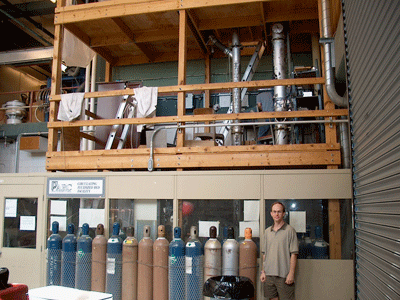Circulating Fluidized Bed (CFB) Research at Cornell
Circulating fluidization is a technology for carrying out
gas-solid reactions with high solid throughputs, such as coal
combustion or catalytic cracking. Excellent contacting is achieved as
solids are entrained in a vertical riser column by a stream of reactive
gases at high velocity.
In 1985, we recognized that limited understanding of circulating
fluidized beds (CFB) rendered design extrapolations of pilot reactors
to full-scale plants both empirical and expensive. In this context, we
built at Cornell in 1986 the first cold
circulating fluidized bed
experimental facility capable of recycling any arbitrary mixture of
inert gases at room-temperature (helium, air, CO2, SF6).
In doing so, we matched the dimensionless numbers of our cold facility to those of industrial units operating at higher temperatures. By changing the gas composition and particle size, we could simulate an increase in the size of the industrial unit, thus allowing us to study effects of scale-up on CFB hydrodynamics with a single facility. We also used the dense gas SF6 to simulate pressurized circulating fluidization.
The facility was decommissioned in 2002.

Results
Our main publications on this subject include:
Chang H. and Louge M.: "Fluid dynamic similarity of circulating fluidized beds," Powder Tech. 70, 259-270 (1992).
In
this work, we investigated effects of scale-up on the hydrodynamics of
circulating fluidized beds (CFB) using a single cold laboratory
facility with the ability to recycle fluidization gas mixtures of
adjustable density and viscosity. By matching five dimensionless
parameters, experiments employing plastic, glass and steel powders
achieved hydrodynamic similarity with high-temperature CFB risers of
0.32, 0.46 and 1m diameter.
Comparisons of results obtained with the plastic and glass powders
indicated that static pressure and its fluctuations scale with the
riser and particle diameters, respectively. Experiments with the steel
powder exhibited incipient choking behavior consistent with the greater
analogous bed size that they simulate. The onset of choking with
plastic and steel powders was well predicted by the correlation of Yang
[Powder Technology 35, 143 (1983)].
Experiments with coated glass beads also showed that the magnitude of the Coulomb friction coefficient affects CFB hydrodynamics in the limit where this coefficient is small.
An excerpt of Chang and Louge (1992) is available
here.
Louge M.Y., Bricout V. and Martin-Letellier S.: "On the dynamics of pressurized and atmospheric circulating fluidized bed risers," Chem. Eng. Sci. 54, 1811-1824 (1999).
We used our CFB facility to investigate the effects of gas density,
scale and operating conditions on circulating fluidized bed
risers. By matching five dimensionless parameters, experiments
employing plastic and glass powders fluidized with mixtures of sulfur
hexafluoride, carbon dioxide, helium and air near ambient temperature
and pressure achieved hydrodynamic similarity with generic
high-temperature risers of variable scale operating at pressures of 1
and 8 atm.
We interpreted results in the upper riser using steady,
fully-developed momentum balances for the gas and solid phases.
The analysis showed that, for a wide range of experiments, two
parameters capture the dependence of the pressure gradients upon the
ratio of the mean gas and solid mass flow rates. The first is the
ratio of the mean particle slip and superficial gas velocities.
The second represents the spatial correlation between the radial
profiles of interstitial gas velocity and voidage. Variations of
the first with dimensionless parameters indicated that the
“atmospheric” and “pressurized” experiments conform to distinct viscous
and inertial regimes.
An excerpt of Louge, Bricout and Martin-Letellier (1999)
is available here.
V. Bricout and M. Louge: “Measurements of cyclone performance under conditions analogous to pressurized circulating fluidization,” Chem. Eng. Sci. 59, 3059-70 (2004).
We evaluate the performance of a relatively efficient cyclone
operating under conditions analogous to a generic pressurized
circulating fluidized bed at high solid loading.
Elizabeth Griffith and M. Louge: “The Scaling of Cluster Velocity at the Wall of Circulating Fluidized Bed Risers,” Chem. Eng. Sci. 53 (1998).
In this paper, we noted a simple relation for the speed at which
particle clusters descend at the wall of circulating fluidized beds, U
= 36√gd.
The relation holds for a remarkable range of conditions.
An excerpt of Griffith and Louge (1998) is
available here.
Elizabeth Griffith and M. Louge: “Convective heat transfer scaling at the wall of circulating fluidized bed risers,” AIChE meeting, Los Angeles (2000).
In this paper, we investigate experimentally the scaling of heat transfer at the wall of circulating fluidized bed using a unique capacitance probe fitted with a small platinum coil held at constant temperature.V. Bricout and M. Louge: “A verification of Glicksman's reduced scaling under conditions analogous to pressurized circulating fluidization,” Chem. Eng. Sci. 59, 2633-38 (2004).
This paper provides evidence of the validity of Glicksman's simplified scaling laws for circulating fluidized beds.
A conference paper of Bricout and Louge on this
subject is available here.
Louge M., Lischer D.J. and Chang H.: “Measurements of Voidage near the Wall of a Circulating Fluidized Bed Riser,” Powder Tech. 62, 269-76 (1990).
This papers reports the first measurements of solid volume fraction at the wall of a circulating fluidized bed.
An excerpt of Louge, Lischer and Chang (1990) is
available here.
Louge M. and Chang H.: “Pressure and Voidage Gradients in Vertical Gas-Solid Risers,” Powder Tech. 60, 197-201 (1990).
In
this paper, we pointed out that the customary practice of inferring
average voidage from measurements of vertical pressure gradients can
lead to significant errors at the transition between the dense and the
dilute regions of a circulating fluidized bed riser. In this context,
we developed a one-dimensional model to account for rapid variations of
vertical voidage in these calculations. The model elucidated the
discrepancy observed by Arena, et al. between the voidage profiles
inferred from pressure gradients and those measured by a quick-closing
valve technique.
An excerpt of Louge and Chang (1990) is
available here.
Archives
Conference papers on the subject also
include Louge (1987);
Chang and Louge (1991); Beaud and Louge (1995), Louge, Bricout and Martin-Letellier (1998) and Martin-Letellier and Louge (1995).

